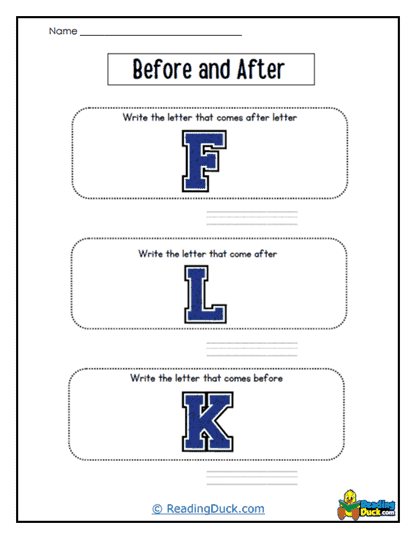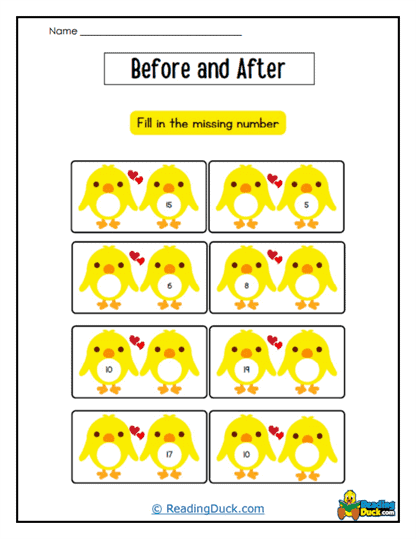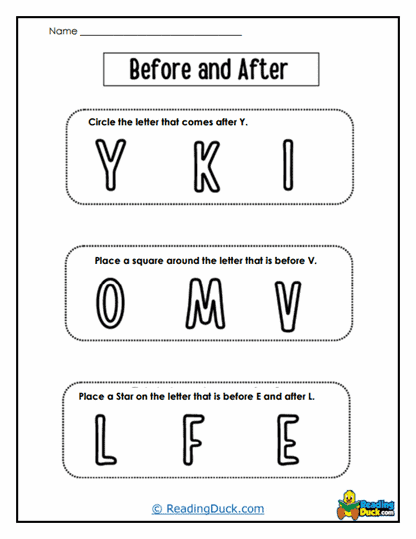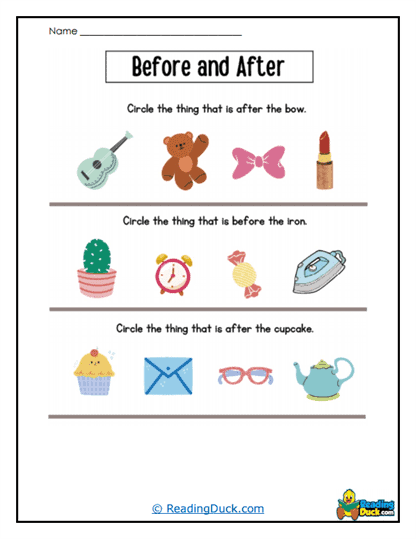Before or After Worksheets
About Our Before or After Worksheets
Our collection of Before or After worksheets is an essential resource designed to help students understand and apply position words, focusing specifically on the concepts of "before" and "after." Falling under the Vocabulary category within the Skills section, these worksheets provide engaging activities that build a solid foundation in spatial reasoning and language development. Whether used in classrooms, homeschool settings, or for independent learning, these worksheets are designed to make the learning process both fun and educational.
All worksheets are available in PDF format, making them easy to view, download, and print for immediate use. Each worksheet comes with a downloadable answer key, simplifying grading and assessment for teachers, parents, and tutors. These materials help students master key vocabulary related to the sequence and spatial relationships of objects and events.
Introducing the Concept of Position Words: Before and After
Position words, particularly before and after, are critical tools in helping students understand both time and space relationships. These words describe where objects, events, or actions occur in relation to one another. As an educator would explain in a classroom, understanding "before" and "after" allows students to follow directions, understand sequences, and describe positions accurately.
For example, in a classroom discussion, a teacher might say: “The number 3 comes before 4, and the number 5 comes after 4.” This simple explanation introduces how these words describe order and sequence in a number line, which can be further applied to storytelling, everyday routines, and more.
Examples of Using Position Words:
- “The apple is before the banana on the table.”
- “The cat came into the room after the dog.”
In addition to spatial relationships, "before" and "after" also describe time sequences: "We eat lunch after we finish our morning lessons." By working through the provided worksheets, students encounter a range of scenarios where they must apply these position words, reinforcing their understanding through repetition and application.
Each worksheet in the collection is designed to guide students step by step, starting with simple exercises and gradually introducing more complex activities. The PDF format allows educators to print the worksheets for immediate use, while the answer key facilitates efficient assessment.
Designed for Diverse Learning Styles
One of the standout features of our Before or After worksheets is their ability to support a range of learning styles, ensuring that each student has the opportunity to engage with the material in a way that works best for them. Understanding that students absorb information differently, we have incorporated visual, auditory, and kinesthetic elements into the activities to make learning accessible and enjoyable for everyone.
How the Worksheets Cater to Different Learners:
- Visual Learners: The worksheets feature clear diagrams and illustrations that help students see the relationships between objects or events. For example, students may be asked to circle the object that comes before or after another in a sequence of images.
- Auditory Learners: Instructions can be read aloud by teachers or parents, allowing auditory learners to internalize the concept of "before" and "after" through verbal repetition. Class discussions about sequences, such as "What happened before lunch?" help auditory learners grasp these terms in context.
- Kinesthetic Learners: These learners benefit from hands-on activities that accompany the worksheets, such as physically arranging objects in order or acting out sequences. For example, students could line up in a specific order, demonstrating who is standing before or after their peers.
This multi-sensory approach keeps students engaged and actively involved in the learning process, increasing their chances of mastering the concept of position words. By catering to individual learning preferences, we ensure that all students can successfully comprehend and use "before" and "after."
Flexibility for a Variety of Educational Environments
Our Before or After worksheets are highly versatile, making them a useful tool across a wide range of educational settings. Whether you are a teacher in a traditional classroom, a homeschooling parent, or a tutor working with students individually, these worksheets can be seamlessly integrated into your curriculum.
Ideas for Using the Worksheets in Different Settings:
- Classroom Activities: Teachers can use these worksheets as part of group activities, where students collaborate to solve sequencing problems. For example, small groups could work together to arrange a series of events in order and discuss their reasoning for which comes "before" and "after."
- Homeschooling: For parents homeschooling their children, these worksheets provide a structured way to introduce and practice position words. The worksheets can be used as daily exercises or enrichment activities to reinforce lessons.
- Independent Study: These worksheets are also perfect for independent assignments. Students can complete them as homework or during independent learning periods, giving them additional practice in applying position words on their own.
- Enrichment and Remediation: Whether used to challenge advanced students or support those needing extra help, these worksheets are flexible enough to be adapted for different skill levels, allowing educators to tailor lessons to meet students’ needs.
The PDF format makes these worksheets easily accessible, so you can use them whenever and wherever you need, whether for group instruction, one-on-one support, or independent learning.
Supporting Early Language Development
For younger learners and those in the process of building their vocabulary and spatial awareness, position words like "before" and "after" are essential for language development. These worksheets play a crucial role in enhancing communication skills by teaching students how to describe sequences and relationships between objects and events accurately.
Key Benefits for Early Learners:
- Building Vocabulary: By practicing with these worksheets, students increase their understanding of time and space vocabulary, which is vital for everyday communication. Being able to describe what happens "before" or "after" helps children articulate their thoughts more clearly.
- Enhancing Comprehension: Young learners often struggle with understanding sequences, both in time (like the order of events in a story) and space (such as the placement of objects). These worksheets provide structured, repetitive practice that builds confidence and comprehension.
- Engaging and Interactive: The interactive nature of these worksheets, combined with visual aids, keeps students engaged, helping them retain the concepts they’ve learned. Activities like matching, sequencing, and drawing give students a fun, hands-on way to practice these important skills.
The early mastery of "before" and "after" lays the groundwork for more complex language skills and cognitive tasks that involve ordering and sequencing, such as reading comprehension and logical reasoning.
Beneficial for English Language Learners (ELL)
Our Before or After worksheets are also highly effective for English Language Learners (ELL) who need additional support in mastering position words and spatial vocabulary. The combination of clear visual representations and straightforward examples makes it easier for ELL students to understand and apply these position words in everyday contexts.
How These Worksheets Help ELL Students:
- Visual Support: ELL students benefit greatly from the visual cues provided in each worksheet. Diagrams showing the position of objects or events help students associate the terms "before" and "after" with real-world examples, reducing language barriers.
- Simple Language: The instructions and activities are written in easy-to-understand English, making the worksheets accessible to students with varying levels of language proficiency.
- Practical Application: By engaging in activities like sequencing events or identifying which object comes before or after another, ELL students can practice these vocabulary words in meaningful, real-world situations. This practical application reinforces their understanding of both the words themselves and the contexts in which they’re used.
By offering ELL students opportunities to see, hear, and use the words "before" and "after," these worksheets support both language acquisition and cognitive development.
Educator Strategies for Teaching "Before" and "After"
To help students achieve mastery of position words, educators can implement a variety of teaching strategies that reinforce the concepts of "before" and "after." These strategies ensure that students fully understand the relationship between objects and events and can apply their knowledge confidently.
Effective Teaching Strategies:
- Use Timelines: Create visual timelines in the classroom to illustrate the order of events. Students can place different actions or events on the timeline, showing what happened "before" and "after" a specific point.
- Incorporate Movement: For a hands-on approach, have students act out sequences of events. For instance, they can line up according to who went through a door first, second, and so on. This physical involvement helps kinesthetic learners grasp the concept.
- Daily Routine Reinforcement: Use everyday classroom routines to reinforce the use of "before" and "after." For example, remind students that lunch happens after math class, or ask them what activities come before recess. This constant repetition helps cement the meaning of the words.
- Story Sequencing: Have students read or listen to stories, then ask them to place events in order, discussing what happened before and after each major event. This helps with comprehension and encourages students to think critically about sequences.
By incorporating these strategies, educators can ensure that students not only understand the meaning of "before" and "after" but also feel confident using these words in both academic and everyday contexts.
Conclusion
Our collection of Before or After worksheets offers a comprehensive, engaging, and flexible resource for teaching essential position words. Whether used in traditional classrooms, homeschools, or independent learning settings, these worksheets provide structured, interactive practice that supports vocabulary development, spatial awareness, and language skills. With accommodations for different learning styles, support for early learners, and tailored exercises for English Language Learners, these worksheets are a versatile tool for helping students master the concepts of "before" and "after."









